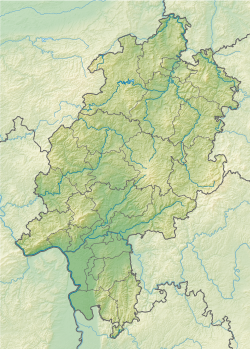Long stone (Langenstein)
| Long stone (Langenstein) | ||
|---|---|---|
|
The long stone of Langenstein |
||
|
|
||
| Coordinates | 50 ° 49 '58.1 " N , 8 ° 57' 29.9" E | |
| place | Kirchhain , OT Langenstein , Hesse , Germany | |
The Lange Stein von Langenstein , a district of the town of Kirchhain in Hesse , is one of several menhirs with this name.
Originally measuring 6.3 meters by 2.30 meters and now only 5.0926 meters high after a lightning strike in 1527, the spindle or cylinder ax-shaped stone stands in the center of Langenstein on the cemetery wall. The place is an old place of worship. There's a church here not for nothing. The Christianization of places of worship like the one in Langenstein was in the hands of Bonifatius , who was entrusted with the Germanic missionary work by Pope Gregory II (715-731) and moved the religious center a few meters in 723 with the construction of a chapel dedicated to St. James the long stone aside without touching it. The long stone is not built into the churchyard wall. There is an air gap between the wall and the stone. It has always been like that, regardless of any restoration work on the wall.
Legend and tradition
The legend about the menhir follows a widespread pattern. A woman had missed going to church on Sunday while mowing. When she noticed this, she took the scythe and whetstone with her and set them down on the churchyard wall. When she came back the scythe was hanging on the wall, but the whetstone was enlarged to gigantic proportions. Although the long stone resembles a whetstone, the legend would remain obscure, if it were not in connection with prehistoric places of worship, the custom of the ritual sharpening of tools or weapons on certain stones has been handed down. It is a custom related to drilling pots (for extracting stone dust). In the lower part of the Long Stone there are also some indentations that have not been investigated.
A custom passed down in the context of the Long Stone says that up until the Middle Ages, bridal couples from the area with bare buttocks would slide along the stone in order to secure a great blessing for children. Similar fertility rituals are common across Europe.
literature
- Gerd Bauer: Mysterious Hessen: Facts, legends and magic. 2nd edition, Marburg 1993, pp. 180ff.
- Claus Dobiat: men hir - long stone. The menhir in Langenstein, town of Kirchhain, Marburg-Biedenkopf district. Archaeological monuments in Hesse 65. Wiesbaden 1987.
- Gisela Graichen : The cult place book. A guide to old sacrificial sites, shrines and places of worship in Germany. Hamburg 1990 p. 220.
- Johannes Groht : Menhirs in Germany. State Office for Monument Preservation and Archeology Saxony-Anhalt, Halle (Saale) 2013, ISBN 978-3-943904-18-5 , p. 152.
- Fritz-Rudolf Herrmann , Albrecht Jockenhövel : The prehistory of Hesse . Theiss, Stuttgart 1990, ISBN 3-8062-0458-6 , pp. 421-422.
- Irene Kappel: Stone chamber tombs and menhirs in Northern Hesse (= Guide to North Hessian Prehistory and Early History. Volume 5). Kassel 1978, pp. 67-68.
- Horst Kirchner: The menhirs in Central Europe and the menhir thought (= Academy of Sciences and Literature. Treatises of the humanities and social sciences class. Born 1955, No. 9). Wiesbaden 1955, pp. 171-172.
- Peter Kneißl : The Langenstein and its prehistoric background. Langenstein 1976.
- M. Schmidt: The old stones. Travel to the megalithic culture in Central Europe. Hinstorff, Rostock 1998, ISBN 3-356-00796-3 .
Web links
- The Megalithic Portal: Langenstein in Langenstein

